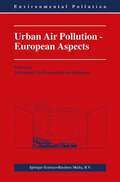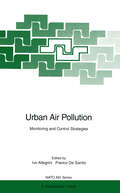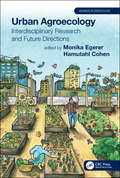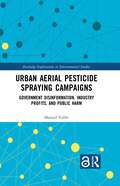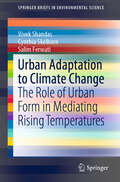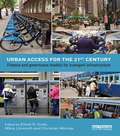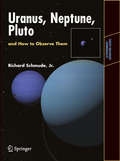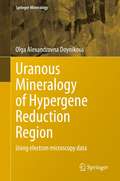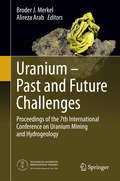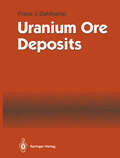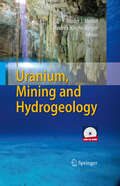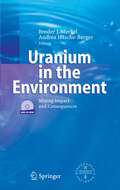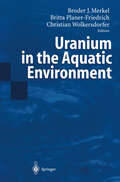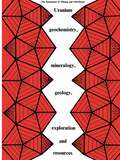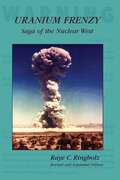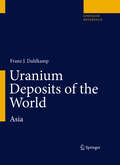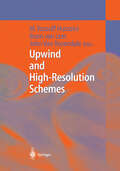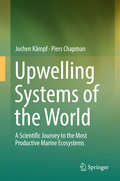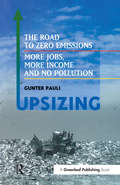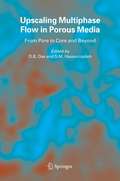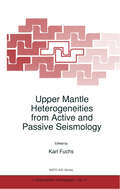- Table View
- List View
Urban Air Pollution - European Aspects (Environmental Pollution #1)
by Brian J. AllowayThis European Community-initiated book presents an up-to-date account of the air pollution situation with special reference to European cities. Its structure follows by and large the logical chain of events in air pollution, from sources, through dispersion and deposition, to impacts.
Urban Air Pollution: Monitoring and Control Strategies (Nato Science Partnership Subseries: 2 #8)
by Ivo Allegrini Franco DeSantisThis book presents the proceedings of a NATO Advanced Research Workshop which was also financially supported by the National Research Council of Italy. The Workshop was held from October 9 to 15, 1994, at the Centro Ettore Maiorana in Erice, Italy. Over 40 researchers from a wide variety of fields attended the Workshop, which brought to attention the ongoing research on various phenomena related to urban air pollution. The presence of high levels of atmospheric pollutants in the air of several urban centres of developed and developing countries causes a great concern among authorities and public opinion. Some 20% of the European population live in cities of more than 500,000 inhabitants and about 40% in cities of more than 50,000. Since exceedance of the Air Quality Guidelines has been observed to occur worldwide, a great effort has been addressed to the control of primary pollutants, but many problems related to secondary pollutants such as nitrogen containing species (nitrogen oxides, nitric and nitrous acid, ni trates) and photochemical oxidants (ozone, PAN and others) are far from being solved. The importance of atmospheric chemistry in understanding the processes occurring in urban atmospheres has been well recognised, thus there is a strong need to exchange experiences and results from urban centres in different Countries. Indeed, atmospheric pollution is very much dependent on the type of emissions which are very different according to the economic development of the urban centre under consideration.
Urban Agroecology: Interdisciplinary Research and Future Directions (Advances in Agroecology #23)
by Monika Egerer Hamutahl CohenToday, 20 percent of the global food supply relies on urban agriculture: social-ecological systems shaped by both human and non-human interactions. This book shows how urban agroecologists measure flora and fauna that underpin the ecological dynamics of these systems, and how people manage and benefit from these systems. It explains how the sociopolitical landscape in which these systems are embedded can in turn shape the social, ecological, political, and economic dynamics within them. Synthesizing interdisciplinary approaches in urban agroecology in the natural and social sciences, the book explores methodologies and new directions in research that can be adopted by scholars and practitioners alike. With contributions from researchers utilizing both social and natural science approaches, Urban Agroecology describes the current social-environmental understandings of the science, the movement and the practices in urban agroecology. By investigating the role of agroecology in cities, the book calls for the creation of spaces for food to be sustainably grown in urban spaces: an Urban Agriculture (UA) movement. Essential reading for graduate students, practitioners, policy makers and researchers, this book charts the course for accelerating this movement.
Urban Agroecology: Interdisciplinary Research and Future Directions (Advances in Agroecology #23)
by Monika Egerer Hamutahl CohenToday, 20 percent of the global food supply relies on urban agriculture: social-ecological systems shaped by both human and non-human interactions. This book shows how urban agroecologists measure flora and fauna that underpin the ecological dynamics of these systems, and how people manage and benefit from these systems. It explains how the sociopolitical landscape in which these systems are embedded can in turn shape the social, ecological, political, and economic dynamics within them. Synthesizing interdisciplinary approaches in urban agroecology in the natural and social sciences, the book explores methodologies and new directions in research that can be adopted by scholars and practitioners alike. With contributions from researchers utilizing both social and natural science approaches, Urban Agroecology describes the current social-environmental understandings of the science, the movement and the practices in urban agroecology. By investigating the role of agroecology in cities, the book calls for the creation of spaces for food to be sustainably grown in urban spaces: an Urban Agriculture (UA) movement. Essential reading for graduate students, practitioners, policy makers and researchers, this book charts the course for accelerating this movement.
Urban Aerial Pesticide Spraying Campaigns: Government Disinformation, Industry Profits, and Public Harm (Routledge Explorations in Environmental Studies)
by Manuel ValléeThis book examines social processes that have contributed to growing pesticide use, with a particular focus on the role governments play in urban aerial pesticide spraying operations.Beyond being applied to sparsely populated farmland, pesticides have been increasingly used in densely populated urban environments, and when faced with invasive species, governments have resorted to large-scale aerial pesticide spraying operations in urban areas. This book focuses on New Zealand's 2002–2004 pesticide campaign to eradicate the Painted Apple Moth, which is the largest operation of its kind in world history, whether we consider its duration (29 months), its scope (at its peak the spraying zone was 10,632 hectares/26,272 acres), the number of sprayings that were administered (the pesticide was administered on 60 different days), or the number of people exposed to the spraying (190,000+). This book provides an in-depth understanding of the social processes that contributed to the incursion, why the government sought to eradicate the moth through aerial pesticide spraying, the ideological strategies they used to build and maintain public support, and why those strategies were effective.Urban Aerial Pesticide Spraying Campaigns will be of great interest to students and researchers of pesticides, environmental sociology, environmental history, environmental studies, political ecology, geography, medical sociology, and science and technology studies.The Open Access version of this book, available at http://www.taylorfrancis.com, has been made available under a Creative Commons Attribution-Non Commercial-No Derivatives (CC-BY-NC-ND) 4.0 license.
Urban Aerial Pesticide Spraying Campaigns: Government Disinformation, Industry Profits, and Public Harm (Routledge Explorations in Environmental Studies)
by Manuel ValléeThis book examines social processes that have contributed to growing pesticide use, with a particular focus on the role governments play in urban aerial pesticide spraying operations.Beyond being applied to sparsely populated farmland, pesticides have been increasingly used in densely populated urban environments, and when faced with invasive species, governments have resorted to large-scale aerial pesticide spraying operations in urban areas. This book focuses on New Zealand's 2002–2004 pesticide campaign to eradicate the Painted Apple Moth, which is the largest operation of its kind in world history, whether we consider its duration (29 months), its scope (at its peak the spraying zone was 10,632 hectares/26,272 acres), the number of sprayings that were administered (the pesticide was administered on 60 different days), or the number of people exposed to the spraying (190,000+). This book provides an in-depth understanding of the social processes that contributed to the incursion, why the government sought to eradicate the moth through aerial pesticide spraying, the ideological strategies they used to build and maintain public support, and why those strategies were effective.Urban Aerial Pesticide Spraying Campaigns will be of great interest to students and researchers of pesticides, environmental sociology, environmental history, environmental studies, political ecology, geography, medical sociology, and science and technology studies.The Open Access version of this book, available at http://www.taylorfrancis.com, has been made available under a Creative Commons Attribution-Non Commercial-No Derivatives (CC-BY-NC-ND) 4.0 license.
Urban Adaptation to Climate Change: The Role of Urban Form in Mediating Rising Temperatures (SpringerBriefs in Environmental Science)
by Vivek Shandas Cynthia Skelhorn Salim FerwatiThis book presents the findings of a three-year study on urban heat in Doha, Qatar, and discusses guidelines and strategies for planning agencies to consider in the context of moderating temperatures to provide pedestrians with greater access to outdoor spaces and greater choice in modes of transport. If modifying urban form can reduce extreme temperatures in one of the hottest places on the planet, then perhaps other communities can learn how to create livable cities during a time of rapid changes to the climate. In fact, despite the periods of extreme heat, strategic planning and management of urban areas can improve residents’ and visitors’ ability to live, work, and move throughout the city comfortably. Doha, Qatar, a city with one of the most extreme climates on earth, has undergone rapid development over the past 40 years. Although cities in the Middle East are expanding at three times the international average (UN Report, 2012), the rapid population and physical growth remain largely unexamined, particularly in terms of the unique conditions, qualities, and characteristics that give rise to these emerging centres. Speed, quality, and extent of urbanization impact neighbourhood-scale environmental conditions, and this book provides evidence that urban forms and materials can help to mediate temporal variation in microclimates and that landscape modifications can potentially reduce temperatures and increase accessibility to outdoor environments. By applying the lessons in this book, communities around the world can better adapt to the increasing frequency, duration and intensity of extreme heat.
Urban Access for the 21st Century: Finance and Governance Models for Transport Infrastructure
by Elliott D. Sclar Måns Lönnroth Christian WolmarThis book sets out a road map for the provision of urban access for all. For most of the last century cities have followed a path of dependency on car dominated urban transport favouring the middle classes. Urban Access for the 21st Century seeks to change this. Policies need to be more inclusive of the accessibility needs of the urban poor. Change requires redesigning the existing public finance systems that support urban mobility. The aim is to diminish their embedded biases towards automobile-based travel. Through a series of chapters from international contributors, the book brings together expertise from different fields. It shows how small changes can incentivize large positive developments in urban transport and create truly accessible cities.
Urban Access for the 21st Century: Finance and Governance Models for Transport Infrastructure
by Elliott D. Sclar Måns Lönnroth Christian WolmarThis book sets out a road map for the provision of urban access for all. For most of the last century cities have followed a path of dependency on car dominated urban transport favouring the middle classes. Urban Access for the 21st Century seeks to change this. Policies need to be more inclusive of the accessibility needs of the urban poor. Change requires redesigning the existing public finance systems that support urban mobility. The aim is to diminish their embedded biases towards automobile-based travel. Through a series of chapters from international contributors, the book brings together expertise from different fields. It shows how small changes can incentivize large positive developments in urban transport and create truly accessible cities.
Uranus, Neptune, and Pluto and How to Observe Them: And How To Observe Them (Astronomers' Observing Guides)
by Richard Schmude, Jr.This book is for two groups of people: those who want to study the remote planets with amateur astronomical equipment, and those who are just interested in learning about our knowledge of the remote planets. The Remote Planets, and How to Observe them is unique in that it gives a completely up-to-date summary of our current knowledge of the remote planets, and also explains how amateur astronomers can contribute to our knowledge of the remote planets. Readers are given some inspiring examples of people who, with modest commercially-made equipment, have made important contributions to our scientific knowledge. The observational section goes into great detail, including optical and CCD photometry, occultation measurements, imaging (including stacking and enhancement techniques) and polarization measurements. There are finder charts (from 2010 to 2026), complete with two sets of star-magnitudes in an appendix (one set of magnitudes are for photoelectric photometry and the other set is for visual photometry)
Uranous Mineralogy of Hypergene Reduction Region: Using electron microscopy data (Springer Mineralogy)
by Olga Alexandrovna DoynikovaThis book offers a comprehensive view of the valuable uranium ores and analytical electron microscopy methods, including electron microdiffraction principles, an essential technique for studying uranous minerals.This book also explains the laws governing the formation of uranium mineral accumulations, based on concepts published by the renowned Russian mineralogist L.N. Belova. It addresses all types of ore uranium concentrations in the hypergene region and schematizes all uranium mineral formation processes. Readers will also find selected examples of different genetic types of uranium deposits of black sooty ores; the data gathered from all findings on ningyoite worldwide, and new crystal chemistry data on tetravalent uranium phosphates.
Uranium - Past and Future Challenges: Proceedings of the 7th International Conference on Uranium Mining and Hydrogeology
by Broder J. Merkel Alireza ArabThis book is the collection of papers from the latest International Uranium Mining and Hydrogeology Conference (UMH VII) held in September 2014, in Freiberg, Germany. It is divided to five sessions: Uranium Mining, Uranium and Phosphates, Clean-up technologies for water and soil. Uranium and daughter nuclides and basic research and modeling. Each session covers a wide range of related topic and provides readers with up to date research and solutions on those matters.
Uranium Ore Deposits
by Franz J. DahlkampAn important prerequisite to the long-term use of nuclear energy is information on uranium ore deposits from which uranium can be economically exploited. Hence the basic purpose of this book is to present an overview of uranium geology, data characteristic for uranium deposits, and a synthesis of these data in the form of a typological classification of uranium deposits supported by more detailed descriptions of selected uranium districts and deposits. An additional goal is to provide access for the interested reader to the voluminous literature on uranium geology. Therefore a register of bibliography as global as possible, extending beyond the immediate need for this book, is provided. The volume presented here was not originally designed as a product for its own sake. It evolved as a by-product during decades of active uranium exploration and was compiled thanks to a request by the Springer Publishing Company. Routine research work on identifying characteristic features and recognition criteria of uranium deposits, combined with associated modeling of types of deposits for reapplication in exploration, provided the data bank. The publisher originally asked for a book on uranium deposits structured as a combined text- and reference book. The efforts to condense all the text into a single publication were soon doomed. The material grew out of all feasible proportions for a book of acceptable size and price, a wealth of data on uranium geology and related geosciences having become available during the past decade, too vast for one volume.
Uranium, Mining and Hydrogeology
by Broder J. Merkel Andrea Hasche-BergerSubject of the book is Uranium and its migration in aquatic environments. The following subjects are emphasised: Uranium mining, Phosphate mining, mine closure and remediation, Uranium in groundwater and in bedrock, biogeochemistry of Uranium, environmental behavior, and modeling. Particular results from the leading edge of international research are presented.
Uranium in the Environment: Mining Impact and Consequences
by Broder J. Merkel Andrea Hasche-BergerUranium is an element to be found ubiquitous in rock, soil, and water. Uranium concentrations in natural ground water can be more than several hundreds µg/l without impact from mining, nuclear industry, and fertilizers. Considering the WHO recommendation for drinking water of 15 µg/l (has been as low as 2 µg/l before) due to the chemical toxicity of uranium the element uranium has become an important issue in environmental research. Besides natural enrichment of uranium in aquifers uranium mining and milling activities, further uranium processing to nuclear fuel, emissions form burning coal and oil, and the application of uranium containing phosphate fertilizers may enrich the natural uranium concentrations in soil and water by far. In October 1995 the first international conference on Uranium Mining and Hydrogeology (UMH I) was held in Freiberg being organized by the Department of Geology at the Technical University Bergakademie Freiberg by the support of the Saxon State Ministry of Geology and Environment. Due to the large scientific interest in the topic of uranium a second conference (UMH II) took place in Freiberg in September 1998. Furthermore, in September 2002 scientists working on the topic of uranium mining and hydrogeology attended the third conference (UMH III) which was jointly held together with the International Mine Water - sociation (IMWA) Symposium 2002. The reviewed papers and posters of the 2002 conference have been published by Springer entitled Uranium in the aquatic en- ronment (edited by Merkel, Planer-Friedrich and Wolkersdorfer).
Uranium in the Aquatic Environment: Proceedings of the International Conference Uranium Mining and Hydrogeology III and the International Mine Water Association Symposium Freiberg, Germany, 15-21 September 2002
by Prof. Dr. Broder J. MerkelPreface Uranium is a radioactive element and a heavy metal which is naturally occurring in ground and surface water. Although uranium is enriched in granites and gneiss ground water from these host rocks often shows low to intermediate uranium con centrations, while some ground waters from sandstone and carbonate aquifers show elevated uranium concentrations up to several hundred mg/1 without man made impact. On the other side, surface water contains increased anthropogenic uranium concentrations due to the intensive use of phosphate fertilizers and in mining areas due to mining and milling activities. Saxony and Thuringia both be ing states of the reunified Germany are probably an area where uranium mining activities have impacted the environment more severely than in any other part of the world. Thus, the federal government of Germany allocated huge amounts of money for the rehabilitation work, a unique proceeding without precedent in min ing history. In October 1995 the first international conference on Uranium Mining and Hydrogeology (UMM I) was held in Freiberg being organized by the Department of Geology at the technical University Freiberg by the support of the Saxon State Ministry of Geology and Environment. Due to the large scientific interest in the topic ofuranium a second conference (UMH II) took place in Freiberg in Septem ber 1998.
Uranium geochemistry, mineralogy, geology, exploration and resources: Published for the Institution of Mining and Metallurgy
by B. De Vivoturning points that, in the course of a few years, have made this The uranium minerals that today are at the centre of worldwide metal an essential raw material. attention were unknown until 1780, when Wagsfort found a First, the destructive property of fission reactions made uranium a metal of fundamental strategic importance, increas pitchblende sample in 10hanngeorgenstadt. This discovery passed unnoticed, however, since Wags fort thought that it ing research in some nations, but the revolution came with the plan for the real possibility of utilizing chain reactions for contained a black species of a zinc mineral-hence the n':lme 'pitchblende' (= pitch-like blende). Seven years later, Klaproth, energy production in place of conventional fuels. while examining the mineral, noted that it contained an oxide Since that time a 'uranium race' has been in progress in many countries-often justified by the well-founded hope of of an unknown metal, which he called 'uranium' in honour of the planet Uranus, recently discovered by Herschel. Klaproth becoming self-sufficient with regard to energy, or at least of also believed that he had separated the metal, but, in fact, the paying off a part of the financial deficit due to increasing fuel imports.
Uranium Frenzy: Saga of the Nuclear West
by Raye RingholzNow expanded to include the story of nuclear testing and its consequences, Uranium Frenzy has become the classic account of the uranium rush that gripped the Colorado Plateau region in the 1950s. Instigated by the U.S. government's need for uranium to fuel its growing atomic weapons program, stimulated by Charlie Steen's lucrative Mi Vida strike in 1952, manned by rookie prospectors from all walks of life, and driven to a fever pitch by penny stock promotions, the boom created a colorful era in the Four Corners region and Salt Lake City (where the stock frenzy was centered) but ultimately went bust. The thrill of those exciting times and the good fortune of some of the miners were countered by the darker aspects of uranium and its uses. Miners were not well informed regarding the dangers of radioactive decay products. Neither the government nor anyone else expended much effort educating them or protecting their health and safety. The effects of exposure to radiation in poorly ventilated mines appeared over time.
Upwind and High-Resolution Schemes
by M. Yousuff Hussaini Bram Van Leer John Van RosendaleOne of the major achievements in computational fluid dynamics has been the development of numerical methods for simulating compressible flows, combining higher-order accuracy in smooth regions with a sharp, oscillation-free representation of embedded shocks methods and now known as "high-resolution schemes". Together with introductions from the editors written from the modern vantage point this volume collects in one place many of the most significant papers in the development of high-resolution schemes as occured at ICASE.
Upwelling Systems of the World: A Scientific Journey to the Most Productive Marine Ecosystems
by Jochen Kämpf Piers ChapmanUpwelling systems are special places in the oceans where nutrient-enriched water is brought into the euphotic zone to fuel phytoplankton blooms that, via marine food-web interactions, create the world’s richest fish resources. This book introduces the reader to the interdisciplinary science of upwelling and provides a comprehensive overview of the world’s most productive marine ecosystems in the context of climate variability, climate change and human exploitation. This material presented is suitable for undergraduate and postgraduate study or just for anyone interested to learn about the creation of life in the oceans and how this is compromised by human activities.
UpSizing: The Road to Zero Emissions: More Jobs, More Income and No Pollution
by Gunter Pauli"Zero emissions" has become a definitive term in the debate on sustainable development in the last few years. This radical book focuses on a world where the waste for one process can become the raw material for another – a cascade of materials once thought worthless supporting new products, new processes and new wealth – as industries that were previously considered unrelated cluster together. A world where new business will be created on an unprecedented scale. This is not just a theory: projects in the agro-industries, based on integrated biosystems, are already up and running in countries as diverse as Fiji, Namibia and Colombia and are fully described in the book, as is the lead given by Japan in terms of the adoption of the concept. In UpSizing, Gunter Pauli, founder of the Zero Emissions Research Initiative (ZERI), examines how the adoption of the Zero Emissions concept not only radically reduces pollution and waste but can contribute significantly to the generation of income and jobs – specifically for those that need them most: the rural poor in less developed countries.
UpSizing: The Road to Zero Emissions: More Jobs, More Income and No Pollution
by Gunter Pauli"Zero emissions" has become a definitive term in the debate on sustainable development in the last few years. This radical book focuses on a world where the waste for one process can become the raw material for another – a cascade of materials once thought worthless supporting new products, new processes and new wealth – as industries that were previously considered unrelated cluster together. A world where new business will be created on an unprecedented scale. This is not just a theory: projects in the agro-industries, based on integrated biosystems, are already up and running in countries as diverse as Fiji, Namibia and Colombia and are fully described in the book, as is the lead given by Japan in terms of the adoption of the concept. In UpSizing, Gunter Pauli, founder of the Zero Emissions Research Initiative (ZERI), examines how the adoption of the Zero Emissions concept not only radically reduces pollution and waste but can contribute significantly to the generation of income and jobs – specifically for those that need them most: the rural poor in less developed countries.
Upscaling Multiphase Flow in Porous Media: From Pore to Core and Beyond
by D. B. Das S. M. HassanizadehThis book provides concise, up-to-date and easy-to-follow information on certain aspects of an ever important research area: multiphase flow in porous media. This flow type is of great significance in many petroleum and environmental engineering problems, such as in secondary and tertiary oil recovery, subsurface remediation and CO2 sequestration. This book contains a collection of selected papers (all refereed) from a number of well-known experts on multiphase flow. The papers describe both recent and state-of-the-art modeling and experimental techniques for study of multiphase flow phenomena in porous media. Specifically, the book analyses three advanced topics: upscaling, pore-scale modeling, and dynamic effects in multiphase flow in porous media. This will be an invaluable reference for the development of new theories and computer-based modeling techniques for solving realistic multiphase flow problems. Part of this book has already been published in a journal. Audience This book will be of interest to academics, researchers and consultants working in the area of flow in porous media.
Upper Mantle Heterogeneities from Active and Passive Seismology (NATO Science Partnership Subseries: 1 #17)
by K. Fuchs600 km giving insight into the 3D structure of the upper mantle. These data are confronted with the requirements of the CTBT for 3D regional seismic models of the lithosphere-asthenosphere system. The two primary purposes of the present work are, first, to present these seismic observations on super long-range profiles in digitised format, using peaceful nuclear explosions (PNE) in the former USSR, and, second, to present the joint thoughts of experts from the deep seismic sounding (DSS) and the comprehensive test ban treaty (CTBT) communities. Implications for petrological and other earth science disciplines are presented. Audience: The CTBT community and earth scientists interested in the 3D structure of the lithosphere-asthenosphere system.
